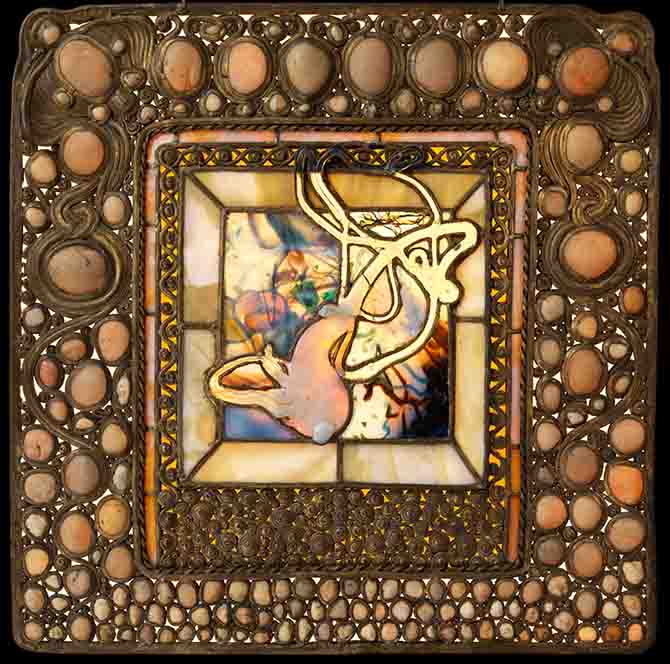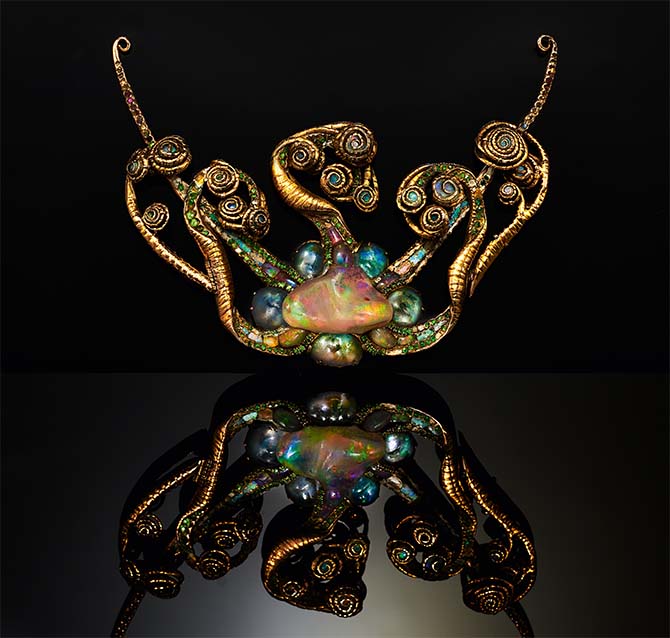
The gold, opal, demantoid garnet and sapphire Medusa pendant by Louis Comfort Tiffany (1902-1904) was part of the artist’s first collection of jewelry. Photo Tiffany & Co.
Jewelry History
The Story of Louis Comfort Tiffany’s Medusa
The magical, almost mythical, jewel is on display at the Tiffany & Co. Landmark
May 22, 2023—On the back wall of the main floor of the Tiffany Landmark in New York City, there are twin display cases flanking the elevator bay decorated with Jean-Michel Basquiat’s giant painting Equals Pi. One case features the 128-carat Tiffany Diamond in a new setting. The Medusa pendant designed by Louis Comfort Tiffany during the early years of the 20th century is in the other case. The two treasures signify two narratives that have been an ongoing part of the Tiffany story almost from the moment the company was established in 1837: excellence in gemology and groundbreaking creativity.
While the story of the Tiffany Diamond is world famous, the fascinating history of Louis Comfort Tiffany’s Medusa is less well-known. And there is good reason for that. The whereabouts of the jewel were a mystery since it was sold in 1943 by the family of the original owner, renowned art collector Henry Walters.
The Medusa, which was inspired by a jellyfish in the Medusa stage of life, gained a mythical status over the years through a colorized black and white photo first published in the 1914 book The Art Work of Louis Comfort Tiffany. Produced as a grand compilation of career highlights, the Medusa was one of only two jewels Louis put in the publication. The lyrical Art Nouveau design and dreamy colors of the creation left an indelible impression on people for generations.

“When I began at Lillian Nassau in the 1980s, I saw the Medusa in the 1914 Tiffany book,” explains Arlie Sulka who took over the gallery specializing in Louis Comfort Tiffany in 2006. “It’s a masterpiece and one of the top five things he ever made. We constantly talked about it over the years, speculating on where it could be or if it was still intact.”
Vintage jewelry dealer and expert Neil Lane, who has a vast collection of Tiffany in his archives, was one of several others who echoed Arlie’s thoughts on the jewel, “We were all looking for the Medusa, then it came up at Sotheby’s.”
In the December 2021 Magnificent Jewelry auction, the Medusa shattered the pre-sale estimate of $100,000 – $200,000. A bidding war, which ended up between three parties, went on for about 10 minutes. When the hammer finally came down at $3,650,000, the jewel set a world record price for any Louis Comfort Tiffany creation.
The Tiffany Archives acquired it. “It was a once in a lifetime opportunity,” explains Christopher Young, VP Creative Director, Creative Visual Merchandising and The Tiffany Archives. “We knew we needed to bring it home.”
There are several reasons for the excitement surrounding the Medusa. Indeed, the jewel has been a source of intense interest from the moment it was created. The piece is from Louis Comfort Tiffany’s very first collection of jewelry for Tiffany & Co. which was launched well-after he had become one of the most celebrated artists in America.

The son of Tiffany & Co. founder Charles Lewis Tiffany, Louis Comfort Tiffany was born in New York City in 1848. As a teenager he began pursuing his dream to be a fine artist, studying painting under American master George Inness. LCT (as he is fondly known) started traveling abroad when he was young taking in art and culture everywhere he went from London, Paris and Rome to Tangier, Cairo and Alexandria.
The overseas trips sharpened his eye and shaped his aesthetic. “When I first had a chance to travel in the east and to paint where the people and the buildings are clad in beautiful hues, the pre-eminence of color in the world was brought forcibly to my attention,” Louis explained while he was giving a talk on his art much later in life.
Insatiably curious and prodigiously talented, Louis continuously added artistic forms of expression to his repertoire including things as diverse as furniture design and photography.
During the 1870s, LCT began experimenting in glass, a medium he would go on to transform. Over the years at his various production studios, he assembled talented teams of artists and experts and closely oversaw the creation of everything from his patented Favrile glass vases to stained-glass windows and lamps.

LCT also became a high-profile interior design talent. Celebrated novelist Mark Twain commissioned him to work on his home in Hartford, Connecticut. President Chester Arthur had Louis revamp several rooms in the White House. His most critically acclaimed interior is the Manhattan home of aesthetes and Impressionist art collectors Louisine and Henry Osborne Havemeyer which he finished in the 1890s.
Louis Comfort Tiffany’s position as one of the greatest creative minds of the turn of the century was absolutely cemented when he won a Grand Prize for his Favrile glass at the 1900 Paris Exposition Universelle that launched the Art Nouveau movement. It was an extraordinary achievement for an American artist competing with staggering French talent.

Louis Tiffany gained fame in the decorative and fine arts working outside of Tiffany & Co. Yet his father supported his efforts in a number of ways including by retailing his work and featuring it in Tiffany’s Blue Book catalogues.
Things changed when Charles Lewis Tiffany died in 1902. The Tiffany & Co. founder bequeathed a substantial inheritance and a controlling interest in the firm to his son. Louis was also made a vice-president and named the first Art Director of Tiffany & Co.
Louis Comfort Tiffany was 54-years old when he began working at Tiffany & Co. and turned his considerable talents to creating jewelry.

The Medusa pendant was part of LCT’s first jewelry collection of around 27 pieces that he worked on over the course of two years with Julia Munson. One of a handful of talented women in the artist’s Tiffany Studios, Julia acted as a collaborator, sounding board and oversaw aspects of manufacturing for the jewelry.
Some of the design hallmarks of LCT’s work in glass can be found in the Medusa pendant. “It reminds me of his early windows made in the 1880s such as the design with the jellyfish at the Metropolitan Museum of Art,” explains Arlie Sulka of Lillian Nassau. “The demantoid garnets are like the little jewels in stained glass. Other gems are reminiscent of his opalescent glass as well as the iridescent glass.”
The unusually shaped opals forming the bell of the jellyfish were most certainly sourced by Tiffany’s head gemologist George Frederick Kunz who is known as the father of American gemology and, among many other things, oversaw the cutting of the 128-carat Tiffany diamond in Paris.

There is a sculptural quality to the Medusa’s gems and goldwork that make it far more three-dimensional than the comparatively flat diamond and platinum Garland Style jewels, the prevailing mode of the era. Hidden joints give the jewel articulation and gentle flexibility where the bell joins with the tentacles.
The arms reaching up on the far sides curl around at the ends to hold a choker length chain necklace, but LCT never displayed it with a necklace. He viewed the piece as an art object.
The signature on the reverse of the pendant underscores his view of the jewel as an artwork. It is the only LCT jewel known to be signed with the word “artist.” The exact inscription says, “Louis C. Tiffany artist.”

While most of the flora and fauna depicted in the jewels from LCT’s debut collection were realistically rendered to echo their actual counterpart in nature, the Medusa is a stylized rendition of a jellyfish. “It screams Art Nouveau,” is how Arlie succinctly describes the look.
Several Art Nouveau designers depicted jellyfish in their creations and it’s easy to understand why. The flowing tenacles of the creature echoed the sinuous lines that defined the style.
French Art Nouveau masters including Émile Gallé and René Lalique are among the many who learned about the look of jellyfish through the illustrations of biologist Ernst Haeckel. Like his contemporaries, it seems almost certain LCT would also have been aware of Haeckle’s work and probably had a copy of his book Art Forms in Nature (initially published in 1899).

Louis Comfort Tiffany’s first collection of jewelry for Tiffany & Co. featuring the Medusa was launched at the 1904 Louisiana Purchase Exposition otherwise known as the St. Louis World’s Fair. At the time, World’s Fairs and International Expositions were epic events that attracted an audience of millions. They were the largest stages where the best-of-the-best showed their wares and platforms Louis had been part of throughout his career.
At the 1904 Exposition, LCT’s jewels were not shown with the gems and minerals from Tiffany & Co. Instead, the collection appeared in the Palace of Arts along with paintings and sculptures. It was a first in international exhibitions for the applied arts to be shown in this arena. The decision undoubtedly delighted Louis.
Once the designs were unveiled, they thrilled the press. Among the publications to cover the collection were Vogue, Town & Country and The Jeweler’s Circular Weekly. A review in The Craftsmen said, “To describe the beauty of these pieces is quite impossible.”

Two years after the St. Louis presentation, the Medusa was exhibited in Paris at the L’Art Decoratif Aux Salons de 1906. Around this time, it was acquired by art collector Henry Walters who eventually gave it to his wife, Sarah.
When it was sold in Mrs. Walters estate in 1943, the mystery buyer was Salman Schocken. It remained in the Schocken family until it was sold at Sotheby’s in 2021 and acquired by The Tiffany Archives.
Now that the Medusa is on display for all to see, I feel certain the legend of the masterwork will grow like the celebrated 128-carat Tiffany Diamond it sits alongside on the back wall of the main floor of the Tiffany Landmark in New York City.
Related Stories:
The Tiffany Diamond Has A Joyful New Setting
Lady Gaga Wears the 128-carat Tiffany Diamond
How The Tiffany Engagement Ring Became An Icon
Get a gem in your mailbox SIGN UP FOR THE ADVENTURINE NEWSLETTER




